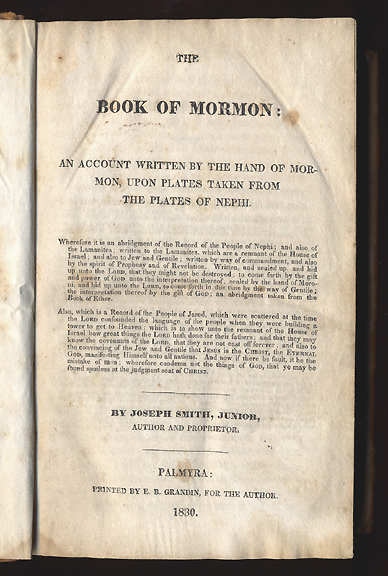Our Easter post from last year is here. It includes a link to a vintage CBC Radio recording of Frye talking about Easter.
Category Archives: Religion
The Book of Mormon
The Book of Mormon was first published on this date in 1830.
We posted on Trey Parker and Matt Stone’s new musical, The Book of Mormon, yesterday. You can watch their South Park episode, “All About Mormons,” here.
Complementing the satire of Parker and Stone, here’s a pertinent observation on parody, with the Book of Mormon cited, in Notebook 44:
All irony, whether of content or of form, is relative to a norm, and is unintelligible without the norm. It seems essential to keep on saying this is an age of “deconstruction,” where the illusion grows up that the norms are no longer there. Tristram Shandy was “odd” to Johnson and “typical” to some Russian formalist [Victor Shklovsky], but it’s not typical of anything but a fashion. (When parody becomes very fashionable, the illusion grows up that the norms have disappeared.)
I suppose the Mormon Bible is a parody of the lost histories of the great civilizations that came pouring over the Bering Straits into the New World. (CW 5, 205-6)
Quote of the Day: “The Book of Mormon”
httpv://www.youtube.com/watch?v=DWkiWtqgOWc&feature=fvst
A reminder that Parker and Stone are also brilliant writers of catchy satirical songs: “It’s Easy, M’Kay,” from Bigger, Longer and Uncut
“All religions constitute an intellectual handicap; the worth of a religion depends on the intellectual honesty it permits. It’s silly to respect all religions: Anglo-Israelitism, for example, is pure shit, and cannot be accepted without destroying one’s whole sense of reality. The Mormons, the Christian Scientists, the fundamentalists, increase the handicap by crippling the brain. Some handicap, probably, one must have: to accept a crippling one. . .is neurotic.” (Denham, Northrop Frye Unbuttoned, 146-7)
An excerpt from Andrew Sullivan’s review of the premier of Trey Parker and Matt Stone’s new Broadway musical, The Book of Mormon.
That is not so say that Matt and Trey are proselytizing. They are merely judging faith by its actions, and judging Mormonism by Mormons. We need a higher calling, they seem to say as an empirical observation; we need a grander narrative; and if religion can do that, and bring compassion to the world, why should we stand in the way?
***
It is the best thing they have ever done – musically, theatrically, comically. They are slowly becoming the Hogarths and Swifts of our time – because by trashing the world with anarchic humor and biting commentary, they are obviously also intent on saving it. And loving it regardless.
Apartheid
httpv://www.youtube.com/watch?v=5s8xkjG8bx4
BBC report on the release of Nelson Mandela from prison in February 1990
South Africans voted in a national referendum to end apartheid on this date in 1992.
Frye in one of the late notebooks links apartheid to the pernicious synthesis of religion and political doctrine:
The worst governments are those with double ideologies, where a political doctrine is backed by a religious one, as in Iran. Israel is better, but I’d hate to have to live even there. But South Africa’s apartheid is buttressed by a remarkably dismal Dutch Reformed creed, and fifty years ago the word “Christian” in the name of a political party meant “Roman Catholic Fascist.” (CW 6, 91)
St. Patrick’s Day
httpv://www.youtube.com/watch?v=TaHMG_SvUkw
The Pogues, “Streams of Whiskey”
On the soberer side of St. Patrick’s Day (that is, any time before about 4 pm), Frye in The Great Code cites St. Patrick’s illustration of the Trinity to make a point about metaphor and doctrine:
The sense in Christianity as a faith beyond reason, which must continue to affirm even after reason gives up, is closely connected with the linguistic fact that many of the central doctrines of Christianity can be grammatically expressed only in the form metaphor. Thus, Christ is God and man; in the Trinity three persons are one; in the Real Presence the body and blood are bread and wine. When these doctrines are rationalized as conceptions of a spiritual substance and the like, the metaphor is translated in metonymic language and “explained.” But there is a strong smell of intellectual mortality about such explanations, and sooner or later they fade away and the original metaphor reappears, as intransigent as ever. At that point we are back to the world where St. Patrick illustrates the doctrine of the Trinity with a shamrock, a use of concrete paradox that enlightens the mind by paralyzing the discursive reason, like the koan of Zen Buddhism. The doctrines may be “more” than metaphors; the point is that they can be stated only in a metaphorical this-is-that form. (CW 19, 73)
Slainte.
Frye Doffs “the Shitty Garment” of Fundamentalism
Vintage postcard of Aberdeen High School, Moncton
John Wesley, the founder of Methodism, died on this date in 1791 (born 1703).
John Ayre in his biography provides this now famous anecdote of the young school boy’s first epiphany. In Frye’s words, he was
walking along St. George St. to high school and just suddenly the whole shitty and smelly garment (of fundamental teaching I had all my life) just dropped off into the sewers and stayed there. It was like the Bunyan feeling, about the burden of sin falling off his back only with me it was a burden of anxiety. Anything might have touched it off, but I don’t know what specifically did, or if anything did. I just remember that suddenly that that was no longer a part of me and never would again. (44)
Islamic Republic of Iran
httpv://www.youtube.com/watch?v=7_0SpjmRAfU
The Shah leaves Iran on February 11th 1979
On this date in 1979 the Iranian revolution established a theocracy under the supreme leadership of Ayatollah Ruholla Khomeini.
From one of the late notebooks:
History redeems: there’s a process within history that isn’t at all what Marxism calls the historical process, but relates to the cultural tradition. People denounced or martyred as horrible heretics in the hysteria of their times later become objects of great cultural interest. The twenty-first century will find The Satanic Verses a document of great interest to scholars and critics, but the Ayatollah will be of no interest to anybody except as one more nightmare of bigotry that history has produced in such profusion. One would hope that eventually the stupid human race would get the point. God doesn’t create post-mortem hells even for people devoting their lives to cruelty and tyranny, but if he did the Ayatollah would certainly be howling in one of them forever. (CW 6, 644)
Simone Weil
Today is Simone Weil‘s birthday (1909-1943).
From The Great Code:
In our day Simone Weil has found the traditional doctrine of the Church as the Body of Christ a major obstacle — not impossibly the major obstacle — to her entering it. She points out that it does not differ enough from other metaphors of integration, such as the class solidarity metaphor of Marxism, and says:
“Our true dignity is not to be parts of a body. . . . It consists in this, that in the state of perfection which is the vocation of each one of us, we no longer live in ourselves, but Christ lives in us; so that through our perfection . . . becomes in a sense each one of us, as he is completely in each host. The hosts are not a part of his body.”
I quote this because, whether she is right or wrong, and whatever the theological implications, the issue she raises is a central one in metaphorical vision, or the application of metaphors to human experience. We are born, we said, within the pre-existing social contract out of which we develop what individuality we have, and the interests of that society take priority over the interests of the individual. Many religions, on the other hand, in their origin, attempt to be recreated societies built on the influence of a single individual: Jesus, Buddha, Lao Tzu, Mohammed, or at most a small group. Such teachers signify, by their appearance, that there are individuals to whom a society should be related, rather than the other way around. Within a generation or two, however, this new society has become one more social contract, and the individuals of the new generations are once again subordinated to it.
Paul’s conception of Jesus as the genuine individuality of the individual, which is what I think Simone Weil is following here, indicates a reformulating of the central Christian metaphor in a way that unites without subordinating, that achieves identity with and identity as on equal terms. The Eucharistic image, which she also refers to, suggests that the crucial event of Good Friday — the death of Christ on the cross — is one with the death of everything else in the past. The swallowed Christ, eaten, divided, and drunk, in the phrase of Eliot’s Gerontion, is one with the potential individual buried in the tomb of the ego during the Sabbath of time and history, where it is the only thing that rests. When this individual awakens and we pass to resurrection and Easter, the community with which he is identical is no longer a whole of which he is a part, but another aspect of himself, or, in the traditional metonymic language, another person of his substance. (CW 19, 119-20)
Caligula
httpv://www.youtube.com/watch?v=YfgDPLkMg-w
From the British television adaptation of Robert Graves’s I, Claudius: Caligula (now incarnated as Jove) addresses the Senate after winning his “battle against Neptune”
On this date in 41 the emperor Caligula was assassinated (born 12).
Frye in The Double Vision:
In religion, too, we must keep a critical attitude that never unconditionally accepts any socially established form of revelation. Otherwise, we are back to idolatry again, this time a self-idolatry rather than an idolatry of nature, where devotion to God is replaced by the deifying of our own present understanding of God. Paul tells us that we are God’s temples [1 Corinthians 3:16]: if so, we should be able to see the folly of what was proposed by the emperor Caligula for the Jerusalem temple, of putting a statue of ourselves in its holy place. (CW 4, 197)
Christians and Muslims
This date represents a couple of significant anniversaries in the history of Christian-Muslim relations.
In 1192 Richard the Lion-Heart was captured and imprisoned by Leopold V of Austria after signing a treaty with Saladin ending the Third crusade.
And in 1522 Suleiman the Magnificent accepted the surrender of the surviving Knights of Rhodes, who were allowed to evacuate, eventually settling on Malta to become the Knights of Malta.
Frye in “Substance and Evidence”:
And just as hope is the beginning of faith, so love is the end of it. Let us think, for example, of a Christian and a Muslim, facing each other in one of the Crusades. Neither of them knows the first thing about the other man’s religion, but they’re both convinced that it is utterly and damnably wrong; they are even prepared to die for that conviction. There must be something the matter with a faith that expresses itself as a desire to kill somebody who doesn’t share it. A profoundly Christian writer, Jonathan Swift, remarked that men have just enough religion to make them hate, but not enough to make them love one another. To which we may add that those who have no religion don’t seem to hate any the less on that account. The general principle here is that whatever reflects any credit on humanity is always attached to something else that’s silly or vicious. As Jesus ben Sirach, the author of Ecclesiastes, says: “What race is worthy of honour? The human race. What race is unworthy of honour? The human race.” [10:19, RSV] (CW 4, 324)




